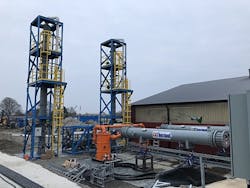Senior Vice President, CG Thermal
Fluids in a chemical process often must undergo either a temperature or phase change — via either heating or cooling — to bring them to a temperature that enables an operation to occur at its optimum point from an efficiency or safety standpoint. Properly selecting, designing, deploying and operating the equipment that heats or cools the fluids are crucial.
For corrosion-resistant heat-transfer materials in harsh and high-temperature processes, there are additional requirements to consider. To help explain existing and emerging technologies to meet specific process and plant conditions, Chemical Processing spoke with Gregory C. Becherer, senior vice president of Twinsburg, Ohio-based CG Thermal.
Q: What are your areas of expertise?
A: Our design teams include mechanical and chemical engineers with expertise in specialized heat and mass transfer systems and design. Originally, we focused solely on ceramic and graphite heat exchangers (the CG in CG Thermal). The industries where we can be found include chloro-alkali, vinyl chloride monomer, fertilizers, titanium dioxide, ethylene dichloride, color additives, specialty chemicals, herbicides and pesticides. Our newer markets include high temperature gas recuperation for syngas and carbon-dioxide capture and other green energy technologies, including heat recovery, energy storage and incineration.
We are a good resource for bigger companies but we really like working with medium-sized to smaller-sized companies that have limited engineering resources. We support their engineering team.
Q: You mention both corrosive environments and high temperature environments. Is there ever an overlap between the two?
A: Historically, the simultaneous need for high temperature resistance and corrosion resistance are not typical. The chemical plants built back in the 60s did not have the materials we have today. They had to limit temperatures in order to stay within the working range of what was available. Most of the corrosive chemical processes are below 200°C.
However, in the newer emerging markets, corrosion at high temperature is a real consideration. In these high applications, mechanisms such as metal dusting and cold-end corrosion need to be considered.
The other problem you get with high-temperature applications is a lot of expansion and contraction. When the unit bundle grows because of the temperature, it is important that the tubes expand at the same rate in order to avoid stress failures at the tube joints.
Q: What about maintenance?
A: This is a very important design aspect. In general, it is important to address access for any heat exchanger or process component that is susceptible to fouling, to allow for inspection and cleaning.
Some fouling can be avoided by proper equipment design. It was very typical for high-temperature applications to replace the heat exchanger every five to seven years. And it was very common to clean these units out once a year. But with advanced design concepts and modeling tools (FEA, CFD), units can be designed for 20-year operating life with infrequent downtime for cleaning.
Can you eliminate fouling? In many applications, it cannot be avoided because of process fluid composition and process parameters. But you can definitely reduce maintenance from a yearly cleanout to a 5- or 10-year cleanout cycle, reducing it to the point where it should no longer be problematic. The key is to design a heat exchanger that’s user friendly — one that you can easily get inside of without disturbing a lot of components, take the ends off, clean it, put it back together in three hours. It’s ignorant if you don’t design for some type of easy access to clean it. I can’t tell you how many times we have looked at existing towers and we can’t understand why they don’t have two, six-inch clean out holes here. Why don’t they have a manway there?
Designed to condense HCl entrained vapor for a soil remediation project in Sweden.
Q: What are the materials of choice for acid processing and when would you recommend one over the other?A: Hydrochloric acid is the reason graphite process equipment was introduced. You’re not using graphite, you’re using impervious graphite. The graphite substrate is porous by nature.
We introduce a phenolic resin into the graphite to make it non-porous so you can use it as a heat-transfer material.
Impregnated Graphite was invented in the 1960s. Up until the late 70s, early 80s, graphite was really your only choice for hydrochloric acid and sulfuric acid at lower concentrations.
But beginning in the 80s, mill technology advanced leading to the introduction of nickel alloys, and the mills learning how to make them economically. So, nickel-alloy metal materials became the common choice for lower concentrations of sulfuric acid. However, for concentrations above 25%, either impervious graphite or silicon carbide (SIC) are required. But when you talk about hydrochloric acid, graphite is still the only way to go. So that’s what I would recommend there.
Now there is a new kid in town — a graphite material that is bonded with a PPS material. We’ve been doing all kinds of corrosion testing and this is my recommendation for hydrochloric and sulfuric acid. It’s cost effective — about one-third of other materials. Its smooth surface reduces the propensity to foul, and it is easy to clean.
As for high-temperature applications, the recommendation is stainless steel and other high-nickel alloys. One really needs to be well versed on those materials in high temperature environments in order to make the proper material choice
Q: Is there ever a disconnect with what customers think they need and what you know they need?
A: We try to help our customers avoid common and uncommon mistakes. We take ownership, listening very carefully and making sure we understand. An example: We’re working on an abatement issue for a sulfuric acid plant in Columbia. When the customer first came to us, they wanted to put an exchanger between two of their catalyst beds. They thought that was the best way to reduce the temperature and the pressure in order to reduce the sulfurdioxide emissions. After discussing, we suggested adding one smaller, additional catalyst bed, moving the exchangers past the main operation and using air-cooled and air-heated heat exchangers to treat the gas and put it into the other bed. We took them from an $800,000 project to two heat exchangers with a total price of under about $185,000. We are very firm believers in bringing in the best technology.
On the flip side, we’ve suggested an upgrade to our ceramic heat exchanger. In this case it is more expensive than graphite but it has a lifetime guarantee against corrosion and erosion. Customers have recognized the benefit and have been switching over. And the reason we do that is because if we don’t bring the best technology, somebody else will. We want that heat exchanger we’re selling you to last 15 years.
Q: What about high-temperature applications and the maximum temperature limits?
A: The highest that we have looked at to date is about 2,400°F. It is really not the maximum process temperature we are concerned with. It is the tube-wall mean metal temperature. We use computer simulation including computational fluid dynamics and finite element analysis to determine mean metal temperatures so we know what the maximum allowable stress of the materials will be, and design accordingly. This can then be ASME SEC VIII Div 1 certified.
Q: What happens if temperatures go higher?
A: When you’re putting in a new piece of equipment, you perform a HAZOP and we are involved with that. We will sit in with you and go over the scenarios. We help you decide what type of safety mechanisms you need to put in. For example, if we’re designing for a 1,200°F maximum tube wall temperature and you have a 2,400°F process stream in the tubes, you must be sure to always have the cold fluid on the shell prior to introducing the hot stream. So you need to make sure there is an interlock to insure that the 2,400°F stream does not see the heat exchanger unless the other cold stream is actually flowing. You have to design in safety and redundancy so that if there is a failure, it will fail safely.
Q: Do you have anything you’d like to add?
A: We specialize is mass and heat transfer of harsh and corrosive process streams, and have gained a lot of expertise from operational expertise over the years. But technologies are continuously changing and evolving. When we need additional resources to tackle these challenges, we are not afraid to seek out others with the required expertise and learn new tricks.
For more information, visit: www.cgthermal.com.


